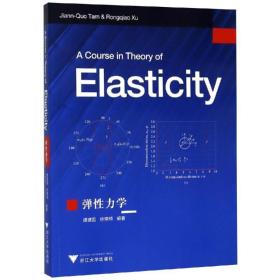
弹力学/谭建国 大中专文科文教综合 谭建国
none
¥ 49.05 7.2折 ¥ 68 全新
库存4件
北京丰台
认证卖家担保交易快速发货售后保障
作者谭建国
出版社浙江大学出版社有限责任公司
ISBN9787308186681
出版时间2018-05
版次1
装帧平装
开本16
页数348页
字数748千字
定价68元
货号xhwx_1201923133
上书时间2024-11-20
- 在售商品 暂无
- 平均发货时间 27小时
- 好评率 暂无
- 最新上架
商品详情
- 品相描述:全新
- 正版特价新书
- 商品描述
-
目录:
chapter 1 mathematical prerequisites
1.1 index notation
1.1.1 range convention
1.1.2 summation convention
1.1.3 the kronecker delta
1.1.4 the permutation symbol
1.2 vector operations and some useful integral theorems
1.2.1 the scalar product of two vectors
1.2.2 the vector product of two vectors
1.2.3 the scalar triple product
1.2.4 the gradient of a scalar function
1.2.5 the divergence of a vector function
1.2.6 the curl of a vector function
1.2.7 lacian of a scalar function
1.2.8 divergence theorem (gausss theorem)
1.2.9 stokes theorem
1.2.10 greens theorem
1.3 cartesian tensors and transformation laws
problems 1
chapter 2 analysis of stress
2.1 continuum
2.2 forces
2.3 cauchys formula
2.4 equations of equilibrium
2.5 stress as a second-order tensor
2.6 principal stresses
2.7 mamum shears
2.8 yields criteria
problems 2
chapter 3 analysis of strain
3.1 differential element considerations
3.2 linear deformation and strain
3.3 strain as a second-order tensor
3.4 principal strains and strain measurement
3.5 patibility equations
3.6 finite deformation
problems 3
chapter 4 linear elastic materials, framework of problems of elasticity
4.1 introduction
4.2 uniaal stress-strain relations of linear elastic materials
4.3 hookes law
4.3.1 isotropic materials
4.3.2 orthotropic materials
4.3.3 transversely isotropic materials
4.4 generalized hookes law
4.5 elastic constants as ponents of a fourth-order tensor
4.6 elastic symmetry
4.6.1 one ne of elastic symmetry (monoclinic material)
4.6.2 two nes of elastic symmetry
4.6.3 three nes of elastic symmetry (orthotropic material)
4.6.4 an as of elastic symmetric (rotational symmetry)
4.6.5 plete symmetry (spherical symmetry)
4.7 elastic moduli
4.7.1 simple tension
4.7.2 pure shear
4.7.3 hydrostatics pressure
4.8 formulation of problems of elasticity
4.9 principle of superition
4.10 uniqueness of solution
4.11 solution approach
problems 4
chapter 5 some elementary problems
5.1 extension of prismatic bars
5.2 a column under its own weight
5.3 pure ben of beams
5.4 torsion of a shaft of circular cross section
problems 5
chapter 6 two-dimensional problems
6.1 ne strain
6.2 ne stress
6.3 connection between ne strain and ne stress
6.4 stress function formulation
6.5 ne problems in cartesian coordinates
6.5.1 polynomial solutions
6.5.2 product solutions
6.6 ne problems in polar coordinates
6.6.1 basic equations in polar coordinates
6.6.2 stress function in polar coordinates
6.6.3 problems with aal symmetry
6.6.4 problems without aal symmetry
6.7 wedge problems
6.7.1 a wedge subjected to a couple at the apex
6.7.2 a wedge subjected to concentrated loads at the apex
6.7.3 a wedge subjected to uniform edge loads
6.8 half-ne problems
6.9 crack problems
problems 6
chapter 7 torsion and flexure of prismatic bars
7.1 saint-venants problem
7.2 torsion of prismatic bars
7.2.1 discement formulation
7.2.2 stress function formulation
7.2.3 illustrative examples
7.3 membrane analogy
7.4 torsion of multiply connected bars
7.5 torsion of thin-walled tubes
7.6 flexure of beams subjected to transverse end loads
7.6.1 formulation and solution
7.6.2 illustrative examples
problems 7
chapter 8 plex variable methods
8.1 summary of theory of plex variables
8.1.1 plex functions
8.1.2 some results from theory of analytic functions
8.1.3 conformal mapping
8.2 ne problems of elasticity
8.2.1 plex formulation of two-dimensional elasticity
8.2.2 illustrative examples
8.2.3 plex representation with conformal mapping
8.2.4 illustrative examples
8.3 problems of saint-venants torsion
8.3.1 plex formulation with eonformal mapping
8.3.2 illustrative examples
problems 8
chapter 9 three-dimensional problems
9.1 introduction
9.2 discement potential formulation
9.2.1 galerkin vector
9.2.2 papkovich-neuber functions
9.2.3 harmonic and biharmonic functions
9.3 some basic three-dimensional problems
9.3.1 kelvins problem
9.3.2 boussinesqs problem
9.3.3 cerrutis problem
9.3.4 mindlins problem
9.4 problems in spherical coordinates
9.4.1 hollow sphere under internal and external pressures
9.4.2 spherical harmonics
9.4.3 asymmetric problems of hollow spheres
9.4.4 extension of an infinite body with a spherical cavity
problems 9
chapter 10 variational principles of elasticity and applications
10.1 introduction
10.1.1 the shortest distance problem
10.1.2 the body of revolution problem
10.1.3 the hrachistochrone problem (the shortest time problem)
10.2 variation operation
10.3 minimization of variational functionals
10.4 illustrative examples
10.5 principle of virtual work
10.6 principle of minimum potential energy
10.7 principle of minimum plementary energy
10.8 reciprocal theorem
10.9 hamiltons principle of elastodynamics
10.10 vibration of beams
10.11 ben and stretching of thin tes
10.12 equivalent variational problems
10.12.1 self-adjoint ordinary differential equations
10.12.2 self-adjoint partial differential equations
10.13 direct methods of solution
10.13.1 the ritz method
10.13.2 the galerkin method
10.14 illustrative examples
10.15 closing remarks
problems 10
chapter 11 state space approach
11.1 introduction
11.2 solution of systems of linear differential equations
11.2.1 solution of homogeneous system
11.2.2 solution of nonhomogeneous system
11.3 state space formalism of linear elasticity
11.3.1 state variable representation of basic equations
11.3.2 hamiltonian formulation
11.3.3 explicit state equation and output equation
11.4 analysis of stress decay in laminates
11.5 application to two-dimensional problems
11.5.1 infinite-ne greens function
11.5.2 half-ne greens functions
11.5.3 a half-ne under line load
11.5.4 extension of infinite te with an elliptical hole
11.6 symplectic characteristics of hamiltonian system
11.6.1 simpie and semisimple systems
11.6.2 non-semisimple system
11.7 application to three-dimensional elasticity
problems 11
references
appendix a basic equations in cylindrical and spherical coordinates
appendix b fourier series
appendix c product solution of biharmonic equation in cartesian coordinates
appendix d product solution of biharmonic equation in polar coordinates
index
内容简介:
主要内容包括笛卡尔张量、应力理论、应变分析、弹力学本构关系、弹力学问题的一般理论、面问题的直角坐标解法和极坐标解法、柱形杆的扭转和弯曲、空间问题和接触问题、热应力、弹波的传播、弹力学问题的复变函数解法、弹力学问题的变分解法等。
作者简介:
作者简介:谭建国美国杜克大学(duke univerity)土木工程系博士,台湾成功大学土木工程系讲座教授、浙江大学建筑工程学院土木系客座教授,中科院航发中心应力分析组教授顾问,中国土木水利工程
相关推荐
— 没有更多了 —


























以下为对购买帮助不大的评价